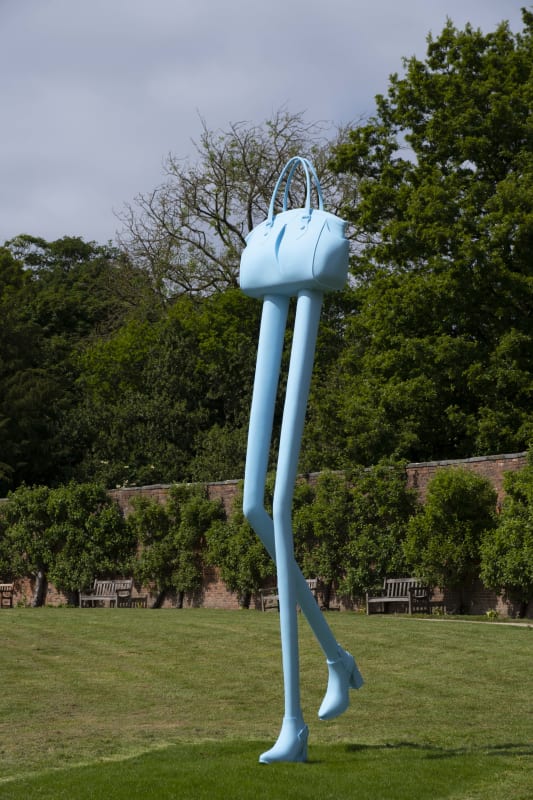‘Humour is a side-effect of my methods’ The absurd sculptures of Erwin Wurm
by Nicolas Wroe
Exhibitions by the Austrian artist Erwin Wurm not only have a distinctive look, they often also have a distinctive sound: embarrassed laughter. Visitors can be seen marvelling at, standing on, or leaning against a variety of objects as incongruously varied as a 1960s caravan, a hot-water bottle with legs, or giant-sized sausages and gherkins.
“Humour is a side-effect of the method I use, of looking at our world from the perspective of the absurd, and sometimes the paradoxical,” says Wurm. “But I’m not interested in making jokes. I think that when we look at our world from a different perspective we might see something different.”
Wurm has been creating his own rules for what defines sculpture since the 1980s, explains Louise Lohr, curator of the first UK museum exhibition of his work, at Yorkshire Sculpture Park near Wakefield. “And his work always generates a lot of joy out of its absurdity. But there is more going on than just silliness. His work is multilayered and while this show is full of fun, it also attempts to draw out the quite complex historical and political motivations that underpin it.”
We are losing freedom of speech. Things are getting closed again, narrower again, in a weird way.
Wurm was born in 1954. Against his conservative parents’ wishes he enrolled in art school in Vienna, and then against his own wishes he was put on the sculpture course despite wanting to be a painter. He responded to his enforced relationship with sculpture by testing its parameters so as to produce something that felt true to himself.
“Austria has a very particular history,” he says. “When I grew up it was still a post-second world war country, there were many Nazis around and it had the structures of a narrow society. From the very beginning I have been exploring this in my work, but I’m not speaking only about Austria. I am speaking generally about our world. We are losing freedom of speech. Things are getting closed again, narrower again, in a weird way.”
Economic necessity initially led him towards using discarded items of everyday life, from leftover building materials to unwanted clothing, and by the late 1980s he had made his first breakthrough. His One Minute Sculptures – although the timescale is actually more arbitrary than that – involved participants following his written or drawn instructions to physically interact with objects such as balls and doorframes. The encounters became the “sculpture” for that brief moment. Sometimes they were documented in photographs or drawings, but more often they only now exist in people’s memories.
Wurm has continued to push at boundaries ever since, whether with his Flat Sculptures – apparently traditional oil on canvas – or his ceramics of dissociated body parts (noses, lips, ears), basic foodstuffs hewn from marble, contorted vehicles or giant handbags sprouting legs. And the humour is always suffused with social awareness and an engagement with philosophy, from Plato’s Ship of Fools to thinkers as varied as Epicurus, Immanuel Kant, Sigmund Freud, Theodor Adorno and more.
The title of the Yorkshire show, Trap of the Truth, comes from Descartes’ explorations into truth and reality, explains Lohr. “And Wurm asks those same questions. How do we know that a person is experiencing the same thing that we’re experiencing? Can we know it? And he asks it through his many curious and wonderful interpretations of sculpture. His combining of performance and action into something that exists as a sculpture can completely shift what people think they know about art, and also what they think they know about life.”
Erwin Wurm: Trap of the Truth is at Yorkshire Sculpture Park, near Wakefield, to 28 April 2024.
Parallel universe: more highlights from the show
Ship of Fools, 2017
This adapted caravan, of a type popular in Austria in the 1960s, is one of Wurm’s largest One Minute Sculptures. By prompting physical interaction with it, Wurm not only provokes laughter but also some embarrassment, says the show’s curator Louise Lohr. “And he wants to encourage that. Not to make fun of people but to identify, spread and normalise that shared feeling of ridicule.”
Untitled, 2018
Sausages and gherkins were the food staples of Wurm’s Austrian upbringing. “As well as this, they may remind people of a very specific part of a man,” he says. “Our history is male-dominated, and our world is in a pretty bad shape and that’s because (or probably because) men were running history over thousands of years – so this is my comment on manhood.”
Wurst, 2021; Modesty, 2021
Wurm’s recent and unexpected use of marble – that most traditional of sculptural materials – to capture everyday objects came “because there is such a contradiction between the bread and the sausage and the marble”, he says. “Transferring something into eternity that would normally last a minute while we eat it – such a symbol of our existence and life.
Step, 2021
Does carrying a designer bag make you a different person? “It can reduce us to a certain habit or taste,” Wurm says. This sculpture of a Hermès Birkin bag asks: “How do we fall into this trap of consumerism?” Like a lot of his work, it returns to the essential questions of identity, how we see ourselves, and how others see us.

















































































































































































